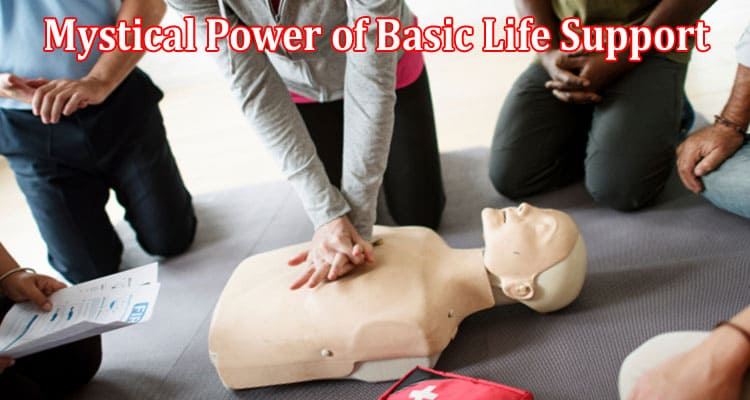Mystical Power of Basic Life Support
In life-saving techniques, the mystical power of Basic Life Support (BLS) takes center stage. BLS is not merely a set of skills; it’s a profound knowledge that can make the difference between life and death in critical situations. In today’s digital age, harnessing this power has become more accessible than ever through an online BLS course. Join us as we delve into the depths of BLS, unlocking its secrets and empowering you with the skills to be a real-life hero.
What Is the Life-Saving Potential of BLS?
Basic Life Support (BLS) is a fundamental set of medical procedures and techniques that can mean the difference between life and death in critical situations.
1. Immediate Response:
- BLS begins with immediate action when someone is found unresponsive and not breathing normally.
- Initiating BLS increases the chances of survival significantly.
2. CPR (Cardiopulmonary Resuscitation):
- CPR is a core component of BLS and involves chest compressions and rescue breaths.
- Compressions help circulate oxygenated blood to vital organs, including the brain.
- CPR maintains minimal blood flow to the heart and brain until advanced medical care arrives.
3. AED (Automated External Defibrillator):
- An AED is a portable device that can deliver an electric shock to restart the heart’s normal rhythm in cases of cardiac arrest.
- When used alongside CPR, AEDs can significantly improve the chances of survival.
4. Airway Management:
- BLS includes ensuring an open airway to facilitate breathing.
- This may involve head-tilt, chin-lift maneuvers, or using airway adjuncts like an Oropharyngeal Airway (OPA) or Nasopharyngeal Airway (NPA).
5. Recognition and Response to Choking:
- BLS also covers techniques to recognize and respond to choking emergencies.
- Abdominal thrusts (Heimlich maneuver) can dislodge obstructing objects in the airway.
6. Incorporating BLS into Daily Life:
- BLS training equips individuals with the skills to respond to emergencies at home, work, or public places.
- It empowers people to act decisively and confidently when faced with life-threatening situations.
Why Is BLS Training Essential?
Basic Life Support (BLS) training is not just a valuable skill; it’s an essential one.
1. Bystander Intervention:
- BLS training empowers bystanders to become first responders, significantly increasing the chances of survival.
- You can make a critical difference in someone’s life before professional help arrives.
2. Chain of Survival:
- BLS is a crucial link in the “Chain of Survival,” a sequence of actions that improve outcomes in cardiac arrest cases.
- The chain includes early recognition, early CPR, rapid defibrillation, and advanced care.
3. Widespread Applicability:
- BLS skills can be applied anywhere, from homes and workplaces to public spaces.
- You’re prepared to respond to emergencies involving family, friends, colleagues, or strangers.
4. AED Utilization:
- BLS includes training on Automated External Defibrillators (AEDs), which can restart the heart’s rhythm.
- Proper AED use can be a game-changer, especially in cases of ventricular fibrillation.
5. Workplace Requirements:
- Many workplaces require employees to have BLS certification, particularly in healthcare, education, and public safety sectors.
- Compliance with these requirements is vital for career advancement and workplace safety.
6. Personal Preparedness:
- BLS training enhances personal preparedness, ensuring you can respond effectively when a loved one’s life is on the line.
- It instills confidence and reduces panic in high-stress situations.
7. Community Resilience:
- A community with widespread BLS knowledge is more resilient in disasters and emergencies.
- Your training contributes to overall community safety.
How Does BLS Restart the Heart in Cardiac Arrest?
To restart the heart during a cardiac arrest using basic life support, follow these key steps:
1. Assess the Situation:
- Ensure safety for yourself and others nearby.
- Check the victim’s responsiveness by tapping and shouting, “Are you okay?”
2. Activate Emergency Response:
- If the victim is unresponsive, immediately call 911 or local emergency services.
3. Perform Chest Compressions:
- Position the victim correctly on a firm surface.
- Place your hands on the lower half of the sternum, interlocking your fingers.
- Administer chest compressions at 100-120 per minute, pushing hard and allowing complete chest recoil.
4. Use an Automated External Defibrillator (AED):
- If an AED is available, switch it on and follow voice prompts.
- Apply the electrode pads to the victim’s chest as directed.
- Analyze the heart rhythm, deliver a shock, and resume CPR if advised.
These four steps are essential in restarting the heart during cardiac arrest. Continue CPR until professional help arrives or the victim shows signs of life. Always prioritize safety and seek advanced medical assistance promptly.
Conclusion
In conclusion, basic life support (BLS) is not just a set of skills; it’s a powerful knowledge that can save lives in critical moments. Through an online BLS course, this mystical power has become more accessible than ever before. BLS equips individuals with the ability to respond swiftly and confidently to emergencies, significantly increasing the chances of survival.




